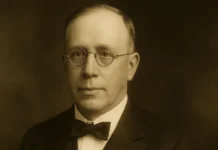The Phenomenology of Touch: Exploring the Depths of Human Connection
If the question is asked without expecting an answer in terms of physiology, an alternative answer may emerge in the domain of the meaning of a caress, transcending the simple physics of the act. The criteria for such a response are rooted in observations regarding the use of contact within human relationships. It becomes clear that the instinctive behavior of touching babies arises from the biological “rightness” of such actions. Without this tactile connection, infants might inevitably lack self-esteem and self-confidence, thereby affecting their psychological and social development. The phenomenological explanation suggests that holding a baby in this way is an expression of valuing or love, as these concepts derive their full meaning from certain acts of touching.
Continuing this explanation leads to the understanding that holding a baby close aims to restore the unity of what was, until recently, a singular entity – mother and child. This becomes an expression of the desire to be in harmony with the child, meeting the baby’s need to be in harmony with his mother. The generic term “love” can be defined philosophically as the desire to merge with that which is loved. In this context, the act of holding becomes an act of love, intrinsically linked to the notion of valuing someone through touch. Many patients intuitively feel this connection on some level during treatment.
Adopting phenomenological explanations allows us to approach touch as a way to express empathy, care, love, concern, desire, fear, insecurity, and more. These explanations refer to the universal use of touch within the broader context of observable psychological and anthropological behaviors and meanings.

For example, during a medical procedure, a patient’s blood pressure might be observed to drop while a nurse holds their hand. It can reasonably be argued that this response is linked to a reduction in patient anxiety, arising from a sense of shared vulnerability with the nurse. This shared vulnerability potentially diminishes the patient’s own sense of vulnerability and reinforces their self-worth, fostering a subconscious realization that they are worthy of being touched. Increased self-esteem, in turn, strengthens the sense of personal power, reducing fear and anxiety. Such explanations, rooted in phenomenology, can legitimately describe the effects of nursing behavior without depending solely on physiological theories such as reduced sympathetic nervous system tone or endorphin release. These physiological effects are probably best explained in terms of anxiety reduction rather than as end products of specific tactile stimulation. In essence, physiological effects arise from psychodynamic events, highlighting the complex interplay between touch, emotions, and human connection.
The Mind-Body Connection: Bridging the Gap Between Science and Soul
In the complex choreography of the interaction between mind and body, contemporary medical thought has adopted a tendency to separate them, placing the greatest emphasis on the physical aspect, even in matters of health where the self, in as an observer, finds its residence in the mind. This deep division has its roots in the decline of mystical and religious ideologies, creating space for the dominance of materialism in Western philosophy.
Historically, ancient religious philosophies recognized the relevance of the soul in understanding and treating health issues, providing a comprehensive and integrated framework. However, with the emergence of scientific thought, particularly in the West, the void left by the disappearance of theosophy was filled by materialist doctrines.
Today, the lure of technological advances has captivated conventional healthcare, aligning with the perception that the human body is entirely anchored in the material world. This perspective aligns with the meticulous scrutiny of modern science, which, while successful, reveals its limitations by operating exclusively in the observable, quantifiable, and physical realm.
Scientific inquiry, with its emphasis on repeatable experiments and inductive reasoning, has eclipsed other forms of inquiry, such as philosophical-psychological exploration. It is crucial to recognize that the strength of science lies in the quantifiable physical world and its desire to be free of value judgments or human characteristics.
This finding highlights the imperative need to balance scientific understanding with broader aspects of human experience. It also recognizes the historical importance of the soul in the context of health and healing. The path to holistic well-being requires the simultaneous recognition and integration of the tangible and intangible elements of our existence.
The rupture between mind and body has its origins in a cultural and philosophical context where mystical and religious ideals have lost their influence. Materialist thinking emerged to fill the void left by these beliefs, focusing more on the physical and observable aspects of human existence. However, this exclusive focus overlooks the crucial influence of the mind on overall health.
Western medicine’s shift toward a largely materialistic approach has been reinforced by technological advances that have captivated the field of conventional health care. This fascination with technology has helped reinforce the idea that human reality can be fully understood through hard data and objective measurements. However, this reductive perspective ignores the more subtle dimensions of human experience, including emotional, psychological, and spiritual aspects.
Modern science, while bringing undeniable advances, has also introduced limitations in its understanding of the complex fabric of human life. Its rigorous approach, focused on observation, measurement and reproducibility, relegated more subjective areas of investigation, such as philosophy and psychology, to the background. This exclusive focus on the observable material can lead to a truncated view of human reality, ignoring the intangible aspects that also contribute to well-being.
The historical emphasis on the soul in ancient religious philosophies provided a balance between the tangible and the intangible. This recognition of the soul as a central element in the understanding of ailments and in healing constituted a holistic framework which is gradually fading in modern medicine.
The current challenge lies in reconciling these two seemingly opposing perspectives. Modern science has brought countless benefits in terms of accurate diagnostics and effective treatments, but its inability to fully integrate the intangible dimensions of human existence creates an imbalance in the medical approach.
Thus, the path to holistic wellness requires a reevaluation of our understanding of health and healing. It is about embracing both scientific rigor and recognition of broader aspects of the human experience. The combination of these perspectives offers significant potential to improve the quality of health care and promote optimal balance between mind and body.
The Quest for Balance between Mind and Body: Descartes, Plato, and the Duality of the Human Being
René Descartes is often considered the architect of the separation between mind and body, a concept that resonates through the halls of philosophical history. However, it should be noted that already in ancient Greece, thinkers contemplated the divisibility of human beings in certain aspects. Plato, a prominent figure in Greek philosophy, developed a worldview where the cosmos exhibits a dualistic nature – abstract, spiritual and intangible on the one hand, and material, corporeal and tangible on the other. In this cosmic dualism, human beings, in Plato’s view, were tripartite, reflecting the structure of the Godhead and laying the foundation for the Christian doctrine of man as the image of the Godhead. Despite their spiritual essence, humans existed in a corporeal realm, housing a material body. Plato held that the true self resided in the soul, which faced a perpetual oscillation between the two polarities.
Plato himself expressed dissatisfaction with the medicine of his time, claiming that it neglected the soul in the healing process. This critique suggested a fundamental tension between ancient mystical and religious traditions, where individuals aspired to elevate themselves from the material to the spiritual, emphasizing intellectual and moral quests, and modern scientific and political strategies which privileged the material existence. The paradox lay in the brilliant application of the mind in disciplines like mathematics, chemistry and physics when studying the body, while the study of the mind itself was denied the same status political, in part because of its resistance to passive observation.
Modern Western society, as Plato might have lamented, has experienced a growing estrangement from the natural, the sensory and bodily awareness, alongside a shift towards materialistic exploration rather than affective understanding. While Plato sought to locate the self in the soul, with particular emphasis on the mind, Descartes deflected this emphasis by placing the self in the abstract mind. His philosophical strategies were mainly aimed at understanding what seemed objective to this abstract mind, notably the body. Despite his belief in God and his support of the healing power of positive thinking, Descartes did not contribute significantly to the exploration or improvement of the mind. This emphasis on the material world, without a satisfactory demonstration of the relationship between the abstract mind and the material body, pushed science toward materialist pursuits.
The unintended consequence of Descartes’ emphasis on the corporeal world, because of its observability, was a discouragement of dialectical philosophy and a diminution of belief in the essential wholeness of mind and body. If the focus had been on the self, not just the body, health or illness could have been located in the individual. Psychology would then have acquired as much respectability as surgery, and psychosomatic medical theory would have become the norm.
Contrary to these possibilities, psychosomatic medicine did not become the norm, and psychology itself was considered unscientific, even pseudo-scientific. It is not so much that mental and emotional phenomena have escaped scientific inquiry, but rather that they have been excluded from it. There is no difficulty in considering psychology as the “science of the psyche” if we remember that the word “science” simply means knowledge or knowledge in general, and not a particular type of knowledge (just as ” “art” is doing in general rather than a particular kind of doing).
Exploring the Multifaceted Dimensions of Psychologically Meaningful Manipulative Touch in Patient-Centered Care
Consideration of psychologically significant manipulative touch brings increased complexity to the field of patient care. While mechanophysiological justifications for tactile interventions may suffice when practitioners deliberately exclude notions of holistic healing and psychology from their therapeutic discussions, the question shifts to the circumstances in which they might possibly avoid doing so.
Although therapeutic touch systematically elicits special psychological events, there are occasions, perhaps many, when it would not be necessary to actively engage with these events. For example, in the context of the sideways fluctuation head rocking technique mentioned earlier, it seems reasonable to assume that a psychological component is more likely to be significant than in a forearm muscle massage. , For example. The head and face, intimately associated with one’s identity, carry a more intense psychological resonance than the arm. Touching the head is inherently more intimate, intensifying the potential psychological impact of the interaction. The nature of the psychological event triggered by the practitioner’s touch, particularly its emotional content, is influenced in part by the area of the body that is touched.
The nature of the act of touching also plays a crucial role in shaping the psychological response. Holding techniques, for example, convey a feeling of “being with,” promoting an active and passive relationship more common when manipulating inanimate objects (procedural touch). In contrast, moving techniques are more like acts of “doing.” This distinction is crucial because it suggests different dimensions of the therapeutic relationship, with expressive touch emphasizing human companionship.
Furthermore, the psychological impact of manual processing goes beyond the nature of touch to encompass anatomical and kinetic criteria. Holding techniques may evoke distinct psychological reactions compared to moving techniques, and slow techniques may elicit different responses than fast techniques. Factors such as light touch versus deep pressure, prolonged contact versus staccato, all contribute to each patient’s unique psychological experience.
While anatomical and kinetic criteria provide relatively predictable results, the individual patient experience remains unique and complex. It involves a symphony of subconscious and conscious elements, interweaving past and present psychological and somatic issues, encompassing aspects such as healing, intimacy, physicality and care. The psychological significance of manual therapy remains a rich and unexplored area for research.
Understanding the various psychological implications associated with different touch modalities is crucial for practitioners aiming to provide patient-centered care. This nuanced approach recognizes the individuality of each patient and tailors the therapeutic encounter accordingly. By recognizing the varying levels of intimacy and potential emotional impact associated with different areas of the body, practitioners can more effectively navigate the intricacies of manipulative touch.
In conclusion, the issue of psychologically significant manipulative touch introduces complexity into therapeutic practices. While mechanophysiological explanations may suffice for some discussions, practitioners must juggle the complex interplay between touch, psychology, and the holistic well-being of the patient. Recognizing the diverse nature of touch and its varied psychological implications highlights the need for an individualized, patient-centered approach to manipulative therapies.
The Diversity of Approaches in Manual Therapy: Between Physiology, Expressivity and Psychological Perspectives
Osteopaths and other manual practitioners are generally considered capable of inducing changes in their patients’ tissues through manipulation. Although some practitioners may object to the dualism implicit in this statement, arguing that they are treating individuals rather than simply manipulating tissues, the use of this type of terminology may be beneficial in clarifying the physiological point of view. Although some practitioners take a more humanistic or holistic approach to therapy, emphasizing treating the whole person, the physiological perspective is crucial to understanding the mechanisms involved in manual therapy.
While a variety of manipulation techniques are described in the literature, there are varying opinions on the conditions under which certain techniques should be used, particularly in the context of dysfunctional tissue states. The literature also offers advice on how best to use these techniques for different conditions. However, patients who have been treated by multiple practitioners likely know that each has a unique approach, even when faced with similar conditions. This diversity is partly explained by the expressive particularities of each practitioner, the way in which they manifest themselves through movement, as well as by the different therapeutic models and approaches adopted.
It is clear that manual practitioners touch their patients in different ways. These differences are partly determined by intellectual conceptions of how change occurs in tissues, based on philosophical, mechanical, and physiological principles, and partly by the individual expressive behavior and attitudes of each practitioner. Psychological theories explaining the results of manipulation are largely absent from the literature, as is the notion of expressive touch depending on the character of the practitioners.

















